No resting, no tricky technique, just perfect, golden, light & airy Madeleines in under 30 minutes! I’m so proud to be sharing my recipe with you today, after weeks of testing I finally have a recipe for the best little butter cakes I’ve ever tasted and you won’t believe how easy they are! Includes a how-to video in the recipe card!
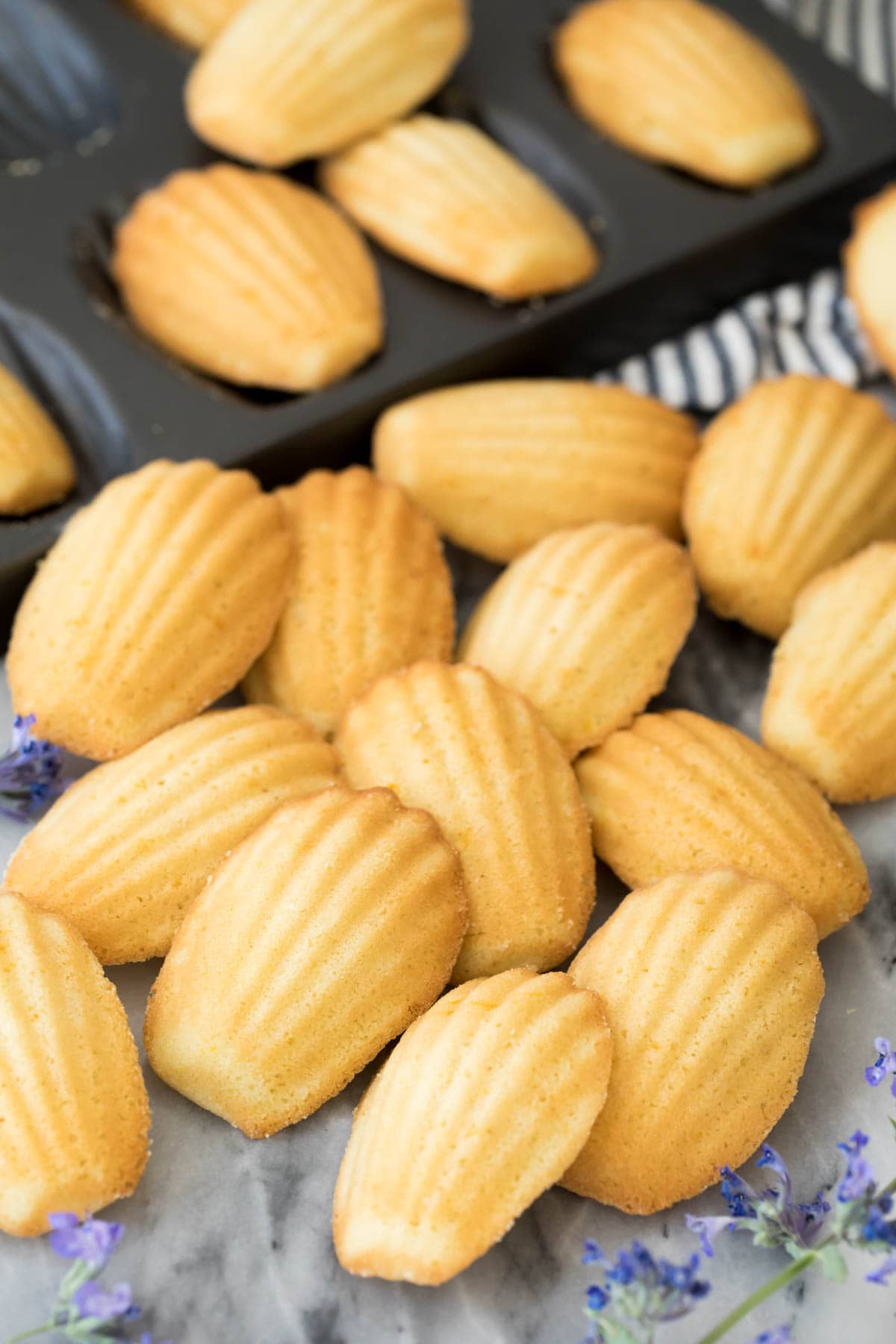
These delicate cookies are shockingly easy to make considering how hard this recipe was for me to crack! Also known as French butter cakes, madeleines are well-known, easily-recognizable, sophisticated little cakes. They have a reputation for being fussy, and what they’re really known for is their scalloped shell-shape and their characteristic bump. It took weeks upon weeks to finally get this recipe perfected, but it was definitely worth it.
If you’ve made madeleines before, you’ll notice that my recipe is fairly different from many traditional recipes. It also produces better results with simpler technique than traditional recipes. There’s no whipping our eggs to “ribbon” stage and there’s no long chilling period (or any chilling period at all). Just perfect madeleines that:
- Are light and airy with a melt-in-your-mouth interior
- Beautiful golden brown with just barely crisp exteriors.
- Perfectly shell-shaped on one side with the classic madeleine “hump” on the other
- Not at all fussy or difficult.
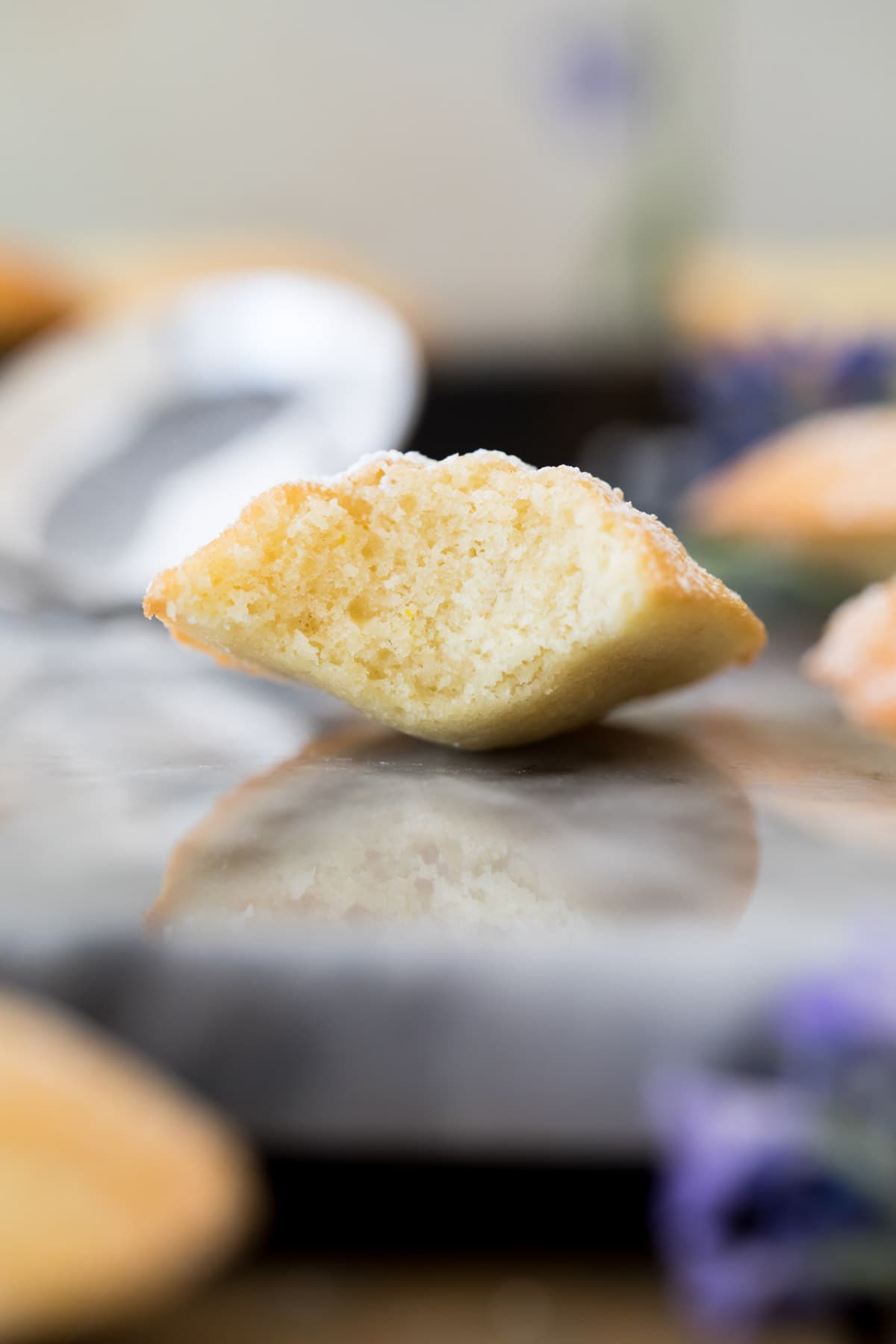
I’ve always been honest with you here. If fussy technique or extra time is needed for the best results, I’m going to encourage you to learn that technique or take that time. Despite my hatred of water baths, I teach you how to use one in my creme brûlée recipe, and I already have my fair share of fussier French recipes (cream puffs and petit fours, to name a few!) in which we’ve tackled different techniques. I was ready to spend paragraphs talking about how to ribbon and the importance of resting (I still talk about it a little below).
But after weeks of testing, it turns out it isn’t necessary after all.
Are They Cookies or Cakes?
Technically, madeleines (or petite madeleines) are small butter cakes. However, because of their shape and size they’re often referred to as cookies. Truthfully they’re mostly like a cross between the two desserts (and who could ask for a better hybrid?). They’re a bit more dense than your average cake recipe, but much, much lighter and fluffier than any cookie.
Whether you call them cookies or cakes, there are two absolutely key characteristics that all madeleines must have: A beautiful scalloped, shell-shaped exterior on one side and a pronounced hump on the other. Check and check ☑️ ☑️
If you’re curious, here’s a brief history on the origins of madeleines.
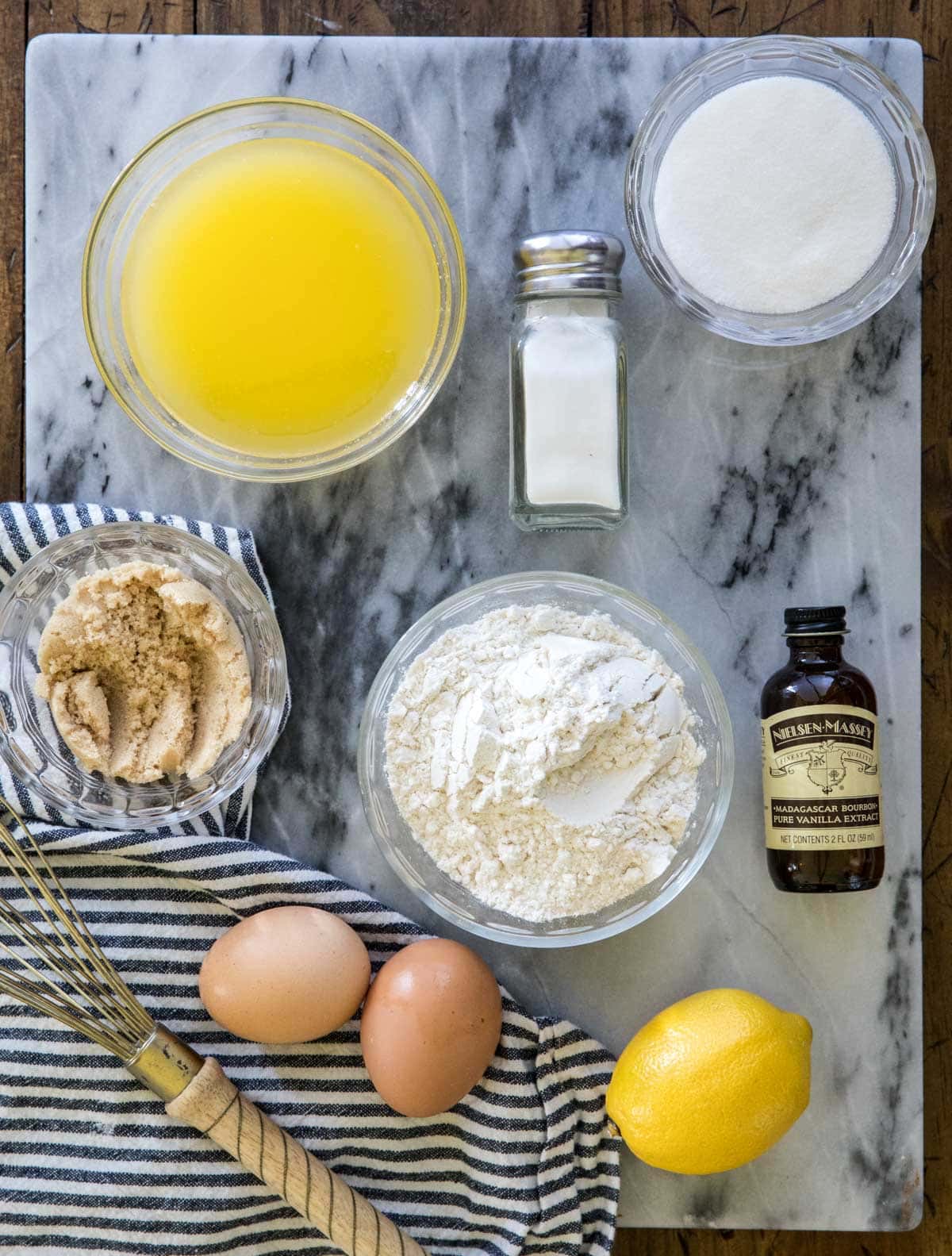
What You Need:
- Butter. My madeleine recipe uses more butter than other recipes you might have tried or seen. It’s not a mistake, this creates more flavorful, more buttery, more delicious madeleines than you’ve seriously ever tasted before. For real. Melt the butter before you begin so that it has time to cool before you add it to your batter.
- Eggs. You need just two eggs for this recipe. Large or extra large will work (and I’ve even used jumbo-sized with success).
- Sugar. I use a blend of granulated and brown sugar. Many madeleine recipes strictly stick to granulated sugar, but adding brown sugar gives the madeleines a richer flavor, a more distinct golden-brown coloring, and it also encourages a little bit of extra caramelization where the batter makes contact with the shell indent in the pan. This adds so much flavor and an extra (slight) crispness to the exterior of the madeleine. It’s just so good! I use slightly more sugar than some traditional recipes, but I don’t recommend reducing the amount. It makes them delicious straight out of the oven, no dusting of powdered sugar or chocolate dip required.
- Vanilla Extract and Salt. For flavor.
- Flour. My recipe uses all-purpose (“plain”) flour. You’ll sift it into your batter (to remove any lumps in the flour) and gently fold in with a spatula. Madeleine batter is fairly thin, like cake batter.
- Citrus Zest (optional). Lemon or orange zest is a common addition, and if I have a fresh citrus fruit lying around I always add some (make sure to avoid the pith!). If you don’t, though, you can skip it and they’ll still be delicious.
Please note that baking powder is not included on this list. Many madeleine recipes use baking powder to help encourage the madeleine hump/belly to form, but it is not necessary here.
Please also note that this is just an overview of the ingredients used. For the full recipe with amounts, please scroll down to the recipe card.
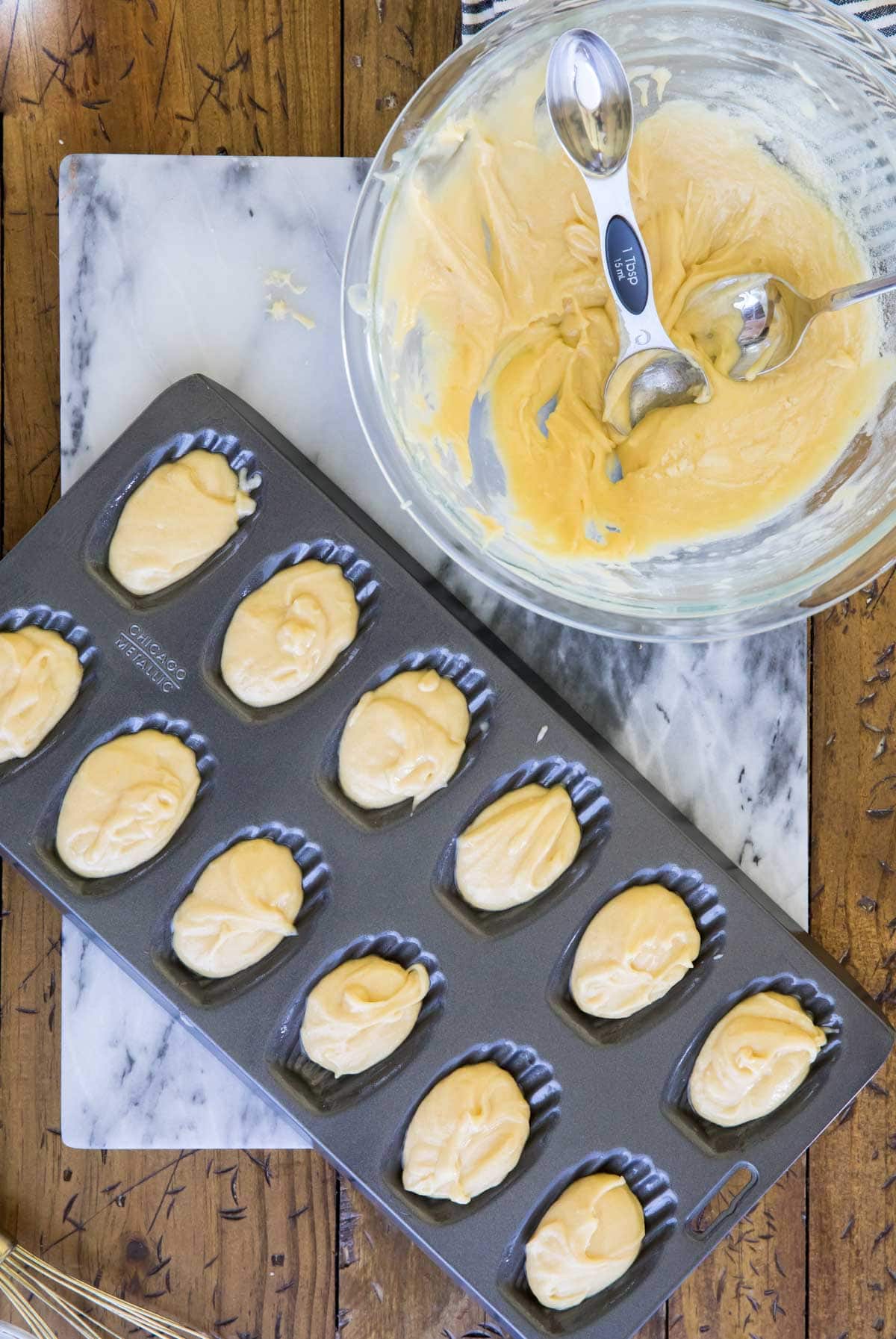
Another Key Ingredient: The Madeleine Pan
Another key “ingredient” is the pan! You absolutely need a scalloped pan like the one seen above in order to make madeleines. It’s the only way to get that characteristic shape. This is the pan that I use.
I use a non-stick pan, but it’s still important to prep the pan before using to make sure that the madeleines don’t stick. Non-stick spray works, but my preference is to mix together melted butter and a pinch of flour and coat the pan with that. It gives the scalloped exterior shell of the madeleine a better, butterier flavor.
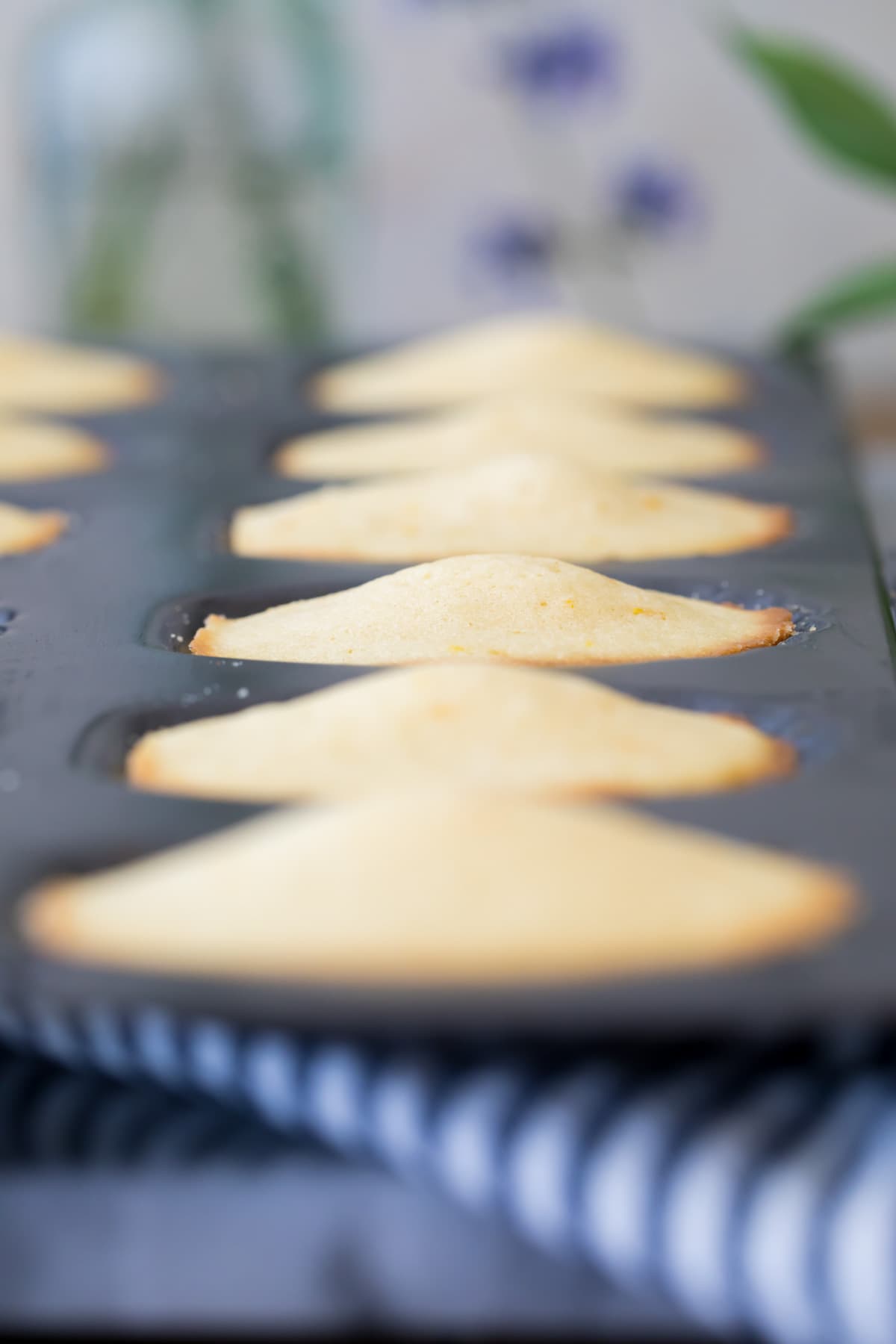
Ribboning and Resting (And Why I do Neither)
Most madeleine recipes call for the batter to be both ribboned and rested before it is baked. My recipe calls for neither, though I tested many, many recipes where I tried both techniques before landing here.
Ribboning (in this instance) is the process of whipping the eggs vigorously (usually with an electric mixer) until the batter is thickened and falls “like a ribbon” from the beater. This incorporates a lot of air into the batter and is typical of a genoise (or, “sponge cake”, which madeleines technically are). My recipe does require you to vigorously whisk the eggs/sugar/salt by hand for a few seconds, but it’s not necessary to go all the way to ribbon stage. With our higher ratio of butter and sugar here, we still end up with a light, delicately cakey interior without needing an electric mixer.
Resting simply means chilling in this situation. Resting helps the batter to thicken and in many recipes it’s essential in order for the hallmark bump or hump of the madeleine to form. The idea is that the chilled batter expands quickly in a hot oven, causing the hump.
Resting is critical with many recipes (even with my crepes I call for at least a half an hour of chilling to help the gluten relax). With some of the madeleine recipes I developed and tested, resting was critical or the madeleines ended up flat (or they spread with crackled edges out of the pan). But with this version, the madeleines still end up with a perfect, buttery-soft interior and that trademark bump, with or without resting.
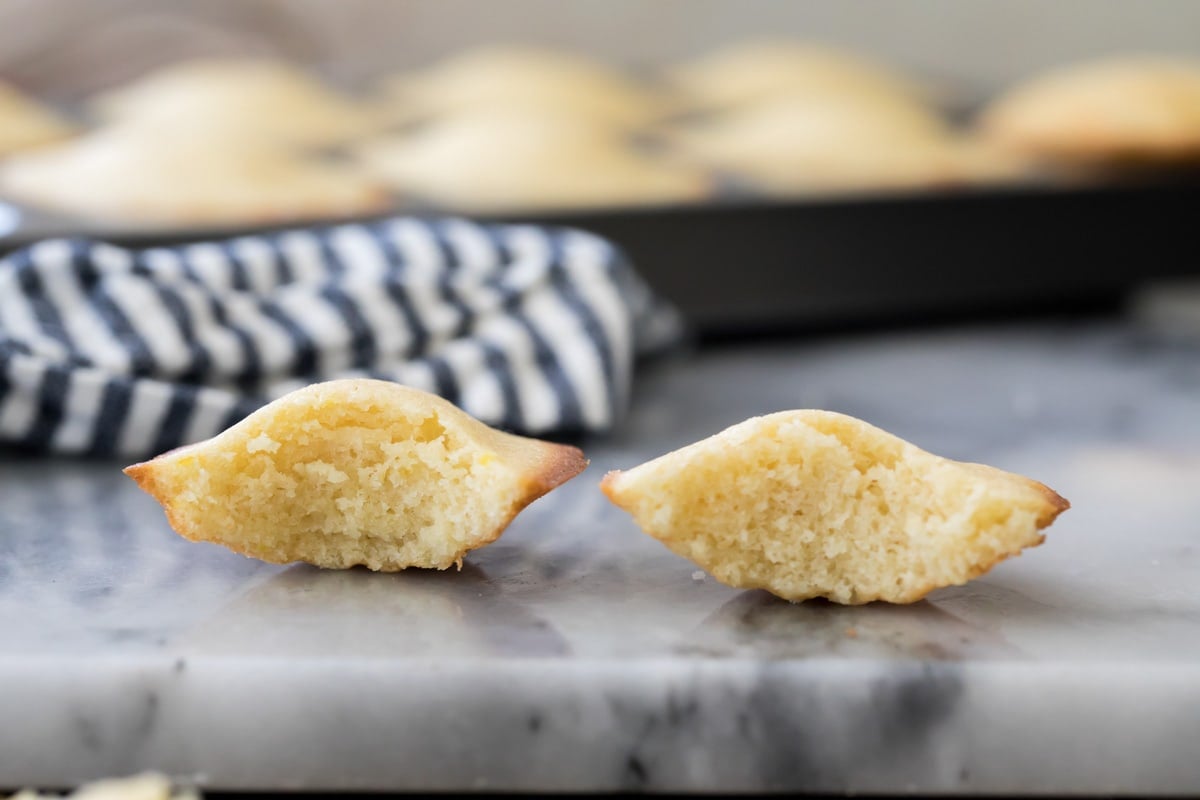
Your batter will thicken while the madeleines rest. If you have a single small pan like I do and need to wait for one batch to bake before using up the rest of the batter, you’ll notice it is much more stiff when you go to bake round two. This is fine and there’s no significant difference in the madeleines made with the thinner or thicker batter. That being said, if you want to make the batter a day or two in advance, you can store it tightly covered in the refrigerator until you are ready to bake.
Toppings
Many madeleine-makers top theirs off with a dusting of powdered sugar just before serving. This adds a nice extra sweetness to the cakes, but while I added some sugar for aesthetics in the photo below my recipe is perfectly sweetened so that no additional sugar is necessary.
A chocolate coating (made of melting chocolate bars, melting wafers, or chocolate chips and then dipping the cakes) is another popular choice, but again it’s not necessary here. Never thought I’d say chocolate isn’t a necessity but somehow here we are.
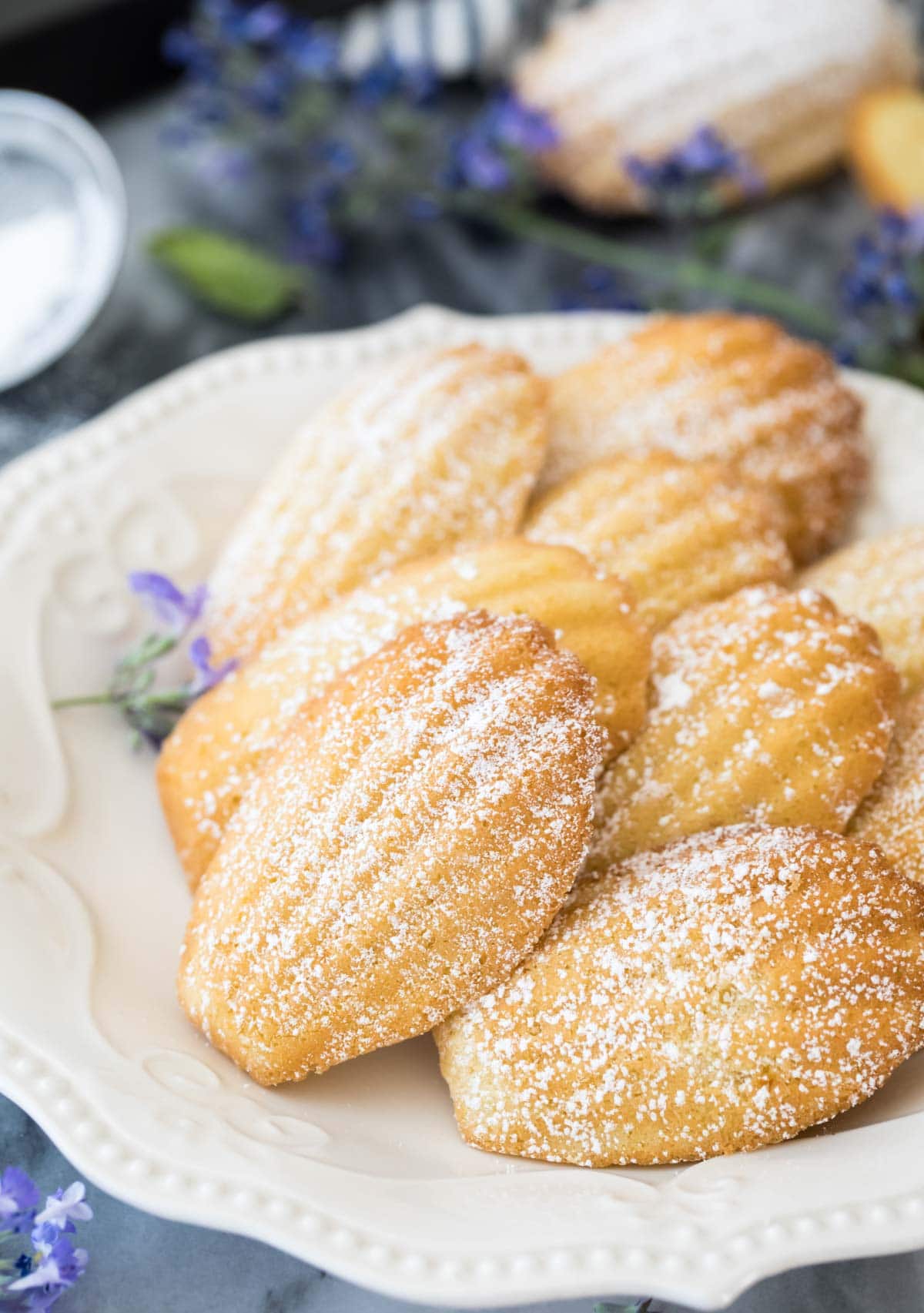
More Recipes You Might Like:
Storing
Madeleines are truly best served fresh, shortly after they are made (even better if they’re still warm!). However, these will keep for up to three days in an airtight container at room temperature. They may also be frozen for at least a month if allowed to cool completely and then frozen in an airtight container. Again though, they’re better fresh!
Enjoy! I really can’t wait to hear how you like these, so please leave me a comment or tag me on Instagram when you try them!
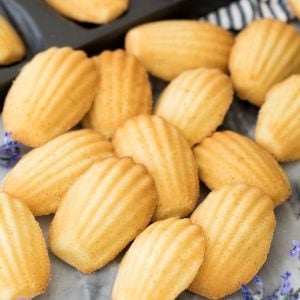
Madeleines (the Best, Easiest Recipe, with Video!)
Ingredients
For Coating the Pan:
- 1 Tablespoon unsalted butter
- 1 ½ teaspoons all-purpose flour
For Madeleines:
- 10 Tablespoons (141 g) unsalted butter cut into pieces
- 2 large eggs room temperature
- ½ cup (100 g) granulated sugar
- 3 Tablespoons light brown sugar firmly packed
- 2 teaspoons vanilla extract
- ⅛ teaspoon salt
- 1 ¼ cup (155 g) all-purpose flour
- 2 teaspoons lemon or orange zest optional
Recommended Equipment
Instructions
- Preheat oven to 375F (190C) and whisk together 1 Tablespoon melted butter and 1 ½ teaspoons flour. Use a pastry brush to lightly but thoroughly grease every cavity of your madeleine pan. Set aside.1 Tablespoon unsalted butter, 1 ½ teaspoons all-purpose flour
- In a small heatproof bowl, melt remaining 10 Tablespoons of butter. Set aside to cool.10 Tablespoons (141 g) unsalted butter
- In a large bowl, combine eggs, sugars, vanilla extract, and salt. Whisk vigorously until thoroughly combined (about 30 seconds).2 large eggs, ½ cup (100 g) granulated sugar, 3 Tablespoons light brown sugar, 2 teaspoons vanilla extract, ⅛ teaspoon salt
- Sift flour into the egg mixture, about ⅓ of the flour at a time, gently stirring into egg mixture after each addition.1 ¼ cup (155 g) all-purpose flour
- Drizzle cooled melted butter around the edge of the batter and add zest, if using. Gently fold into batter using a spatula until ingredients are thoroughly combined (but do not over-mix).2 teaspoons lemon or orange zest
- Drop batter by heaping Tablespoon into prepared pan.
- Transfer to center rack of 375F (190C) preheated oven and bake for 9 minutes or madeleines are light golden brown and spring back when lightly touched. Remove to a cooling rack to cool immediately.
- If your madeleine pan did not hold all of the batter, allow the pan to cool before re-brushing with butter/flour mixture and refilling with batter and baking your next batch.
- If desired, sprinkle madeleines with additional powdered sugar or dip in melted chocolate before serving.
Notes
Storing
Madeleines are best served fresh, but will keep in an airtight container at room temperature for 3 days.Nutrition
Nutritional information is based on third-party calculations and should be considered an estimate only. Actual nutritional content will vary based upon brands used, measuring methods, cooking method, portion sizes, and more.

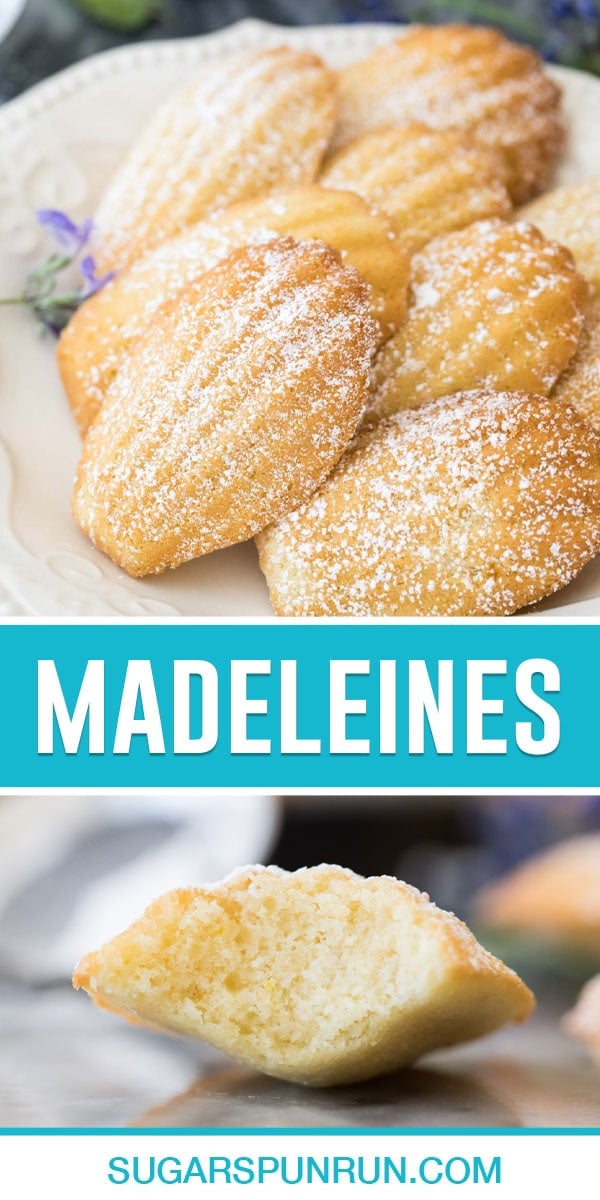
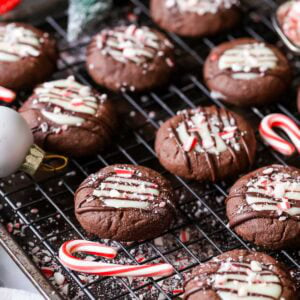

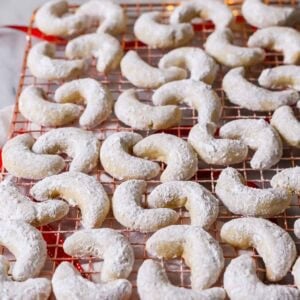

Sarah
Thank you, just what I needed a quick Madeline recipe. My daughter in law made some and I decided to make some for Christmas but her recipe took hours these were ready all baked and washing up done in well under an hour. I’m going to serve them with poached pears and Crème fraiche so the fact they are a bit on the sweet side won’t matter.
Susan Hancock
Easy recipe and quick! Plus, they’re flipping delicious!! Thank you so very much!
M
Can the recipe be doubled?
Sam Merritt
Sure thing! 🙂
Karla
yes and I recommend it,one recipe only made 18.
Kayla
Can I freeze the actual dough?
Sam Merritt
Hi Kayla! I haven’t personally done it. I did a quick search and it looks like many people have done it successfully. Let me know how it goes if you do try it. 🙂
Joy Adams
I tried your recipe, and absolutely love it! I even added the orange zest and love the subtle flavor! Thank you for sharing!!
Emi
For the minimal amount of work put I into these, I was surprised by their texture and consistency. Some, but not all, even had the signature little bump. They’re definitely not as fluffy as a madeleine is supposed to be, but pretty close. Also, I think reducing the sugar wouldn’t hurt! They were VERY sweet.
Jackie
I just tried this recipe, and it worked really well, I thought! I got the perfect hump I was looking for, and this was my first time making them! The madelines were a little bit tough, but that could have been my technique. I’m definitely going to try this again, so I’ll update this when I do.
Lyndsie
So happy I found this recipe!! Madeleines are my absolute favorite cookie/small cake and these are dangerous (I had to stop myself from eating the whole batch in one sitting). This recipe is going to be a staple comfort treat in my house 🙂
Biscuit Babe
Normally I love all the recipes I find here and they need no tweaking. I was hesitant about this recipe but made it as is. This recipe resulted in stodgey madeleines. The sugar and eggs need to be beaten for 4 or 5 minutes until pale yellow and ribbons, that is the only wait to get any rise out of them that gives a light airy texture. It’s also probably better to fold in the flour too, but I’ll need to test that theory.
I didn’t want to be too harsh with my rating, the madeline itself is yummy and once dipped into some tea its fine. It’s not a really great eat on its own because they lack the melt in your mouth quality.
Debra Matullo
I’ve never made madeleines before, but excited to try these and include them in my Christmas cookie boxes this year. However, I make 12 different cookies, so I bake a week or two before boxing them for my customers to aid in time & production. Since they’re better fresh, how should I store these to ensure freshness for my customers? Also, should they be placed inside cellophane bags before placing them with other varieties of cookies to maintain freshness, taste and texture ?
Thank you very much for your time addressing my questions.
Sam Merritt
Hi Debra! These are typically only good for about 3 days in an air tight container at room temperature. You could try freezing them to extend the life a bit, but they really are the best when they are fresh.